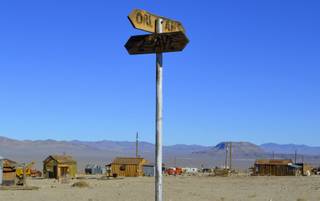
The saloon in Gold Point, which is south of Goldfield, NV, Tuesday, Oct. 22, 2013. The town has 10 year-round residents, if you count three who live outside of what’s considered town limits.
Wednesday, Oct. 23, 2013 | 11:30 a.m.
Herb Robbins didn’t necessarily intend to live in a ghost town, much less own much of one. It just kind of happened.
He grew up in the Sacramento area and, as a teenager, became fascinated with ghost towns and mines after his father took him gold mining. That led Robbins, with a background in construction and restaurants, to explore the West.
Thirty-five years ago, he and his buddy, Chuck Kremin, pulled into Gold Point, which in 1908 was a flourishing gold mining town. They found a handful of die-hards clustered alongside a gravel road proudly named Gold Street, a fair piece off the nearest highway, 190 miles north of Las Vegas.
Kremin stopped to talk to the first person he saw, and after several minutes, he called out to Robbins, “Do you want to buy property here?”
“I said, ‘Sure,’” Robbins recalled, and a few months later, Robbins was part owner of a few empty lots in Gold Point. “Once I got the lots, I got hooked,” he said of his emerging love affair with Gold Point.
Property ownership grew from hobby to avocation. A few years later, Robbins partnered with Chuck Kremin and Chuck’s brother Walt to buy the old post office, the general store and the home of former state Sen. Harry Wiley. Chuck Kremin soon stepped back from an active role, but over the years, Robbins and Walt Kremin have continued to buy and now own about half of the town. Their plan was no more grandiose than to save a bit of Old West heritage.
Robbins, his girlfriend, Sandra Johnson, and Walt Kremin are nearly half the year-round population — seven, not including three people who live nearby.
Robbins and Kremin have spent years going through mining shacks, homes and businesses, trying to stabilize and rehabilitate them. They have re-roofed structures, gutted interiors and added framing, drywall, insulation and electricity. They decorated the cabins with old-fashioned wallpaper and furnished them, giving people who enjoy ghost towns a chance to stay in one.
Although visitors stay in their small RV park and the bed-and-breakfast — the generous euphemism for several renovated miner cabins that are popular with European tourists — breathing fresh life into this hamlet is not about the money. They say they’ve spent far more than they could hope to recover in a lifetime. Such is the price to preserve and share history.
“We want people to enjoy,” Robbins said. “This is our American history out here we’re trying to preserve.”
The state is dotted with places like Gold Point, mining boom towns that shriveled into ghost towns once the gold or silver ran out. People left behind what they couldn’t move, and the town’s weathered remains have lured history buffs, outdoors enthusiasts and vandals over the years. Most of the unwanted people have been surprised and shooed away by the core residents.
Although far from the most historic or important of the old mining boomtowns, Gold Point is remarkable for the persistent efforts to keep it alive. Robbins has led the charge for years, promoting the town through its website.
To draw attention to this place — and raise money for the volunteer fire department, of which he is the chief — Robbins staged big parties and western shows among the small wooden buildings and a gallows, which he added. The parties used to draw as many as 700 people.
An old building was turned into a kitchen for the overnight guests and group gatherings; across from it stands a saloon, which Robbins and Kremin created out of the original telephone and real estate office. It serves more as a museum, housing an eclectic collection of historic artifacts, tools and other trappings of the Old West: an antique dentist chair across from the old barber’s chair, a player piano and a 100-year-old pool table.
Kremin, who was raised in the Bronx, fits in with his straw cowboy hat and with a gun hanging off his hip.
Living here, in some sort of time warp, may sound like a romantic notion to some, but make no mistake, it’s hard. It’s a 60-miles drive to get groceries. The nearest Walmart or Home Depot is a couple of hours away at best. Before cell phones, residents had to drive about a dozen mile to the now closed Cottontail Ranch brothel to use a pay phone. Now they have some service, and they have satellite TV. (A power line was strung across the area in 1968.)
“I admire so much how they (the early settlers) endured. Such a hardy people. “That’s why preserving and saving something is so important.”
And what happens when they’re physically spent and can no longer maintain Gold Point? Both are in their 60s and have cut back on many of the activities they used to do at the town.
“When the time comes, everything goes up for sale, not necessarily to the highest bidder but the person who takes care of it the best,” Robbins said. “Buy it all, we’ll sell you everything with one condition.”
That condition is that they get to live there until they die.
“God forbid we all die and haven’t straightened things out,” Robbins said. “Then who takes it? You create this, a legacy, and who takes care of it?”
The website is: www.goldpointghosttown.com.

 Follow along as the Sun explores and defines Nevada
Follow along as the Sun explores and defines Nevada
Join the Discussion:
Check this out for a full explanation of our conversion to the LiveFyre commenting system and instructions on how to sign up for an account.
Full comments policy